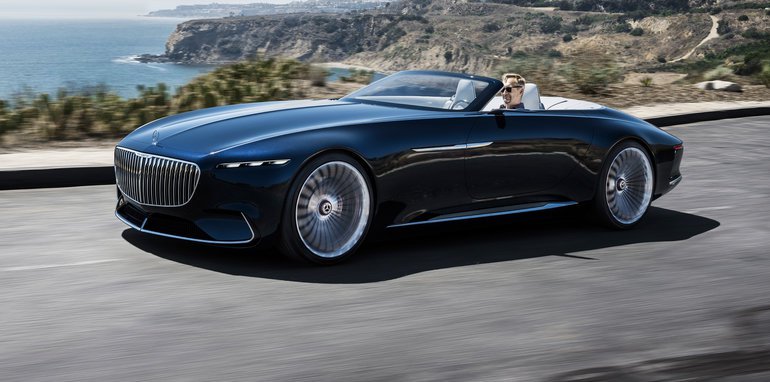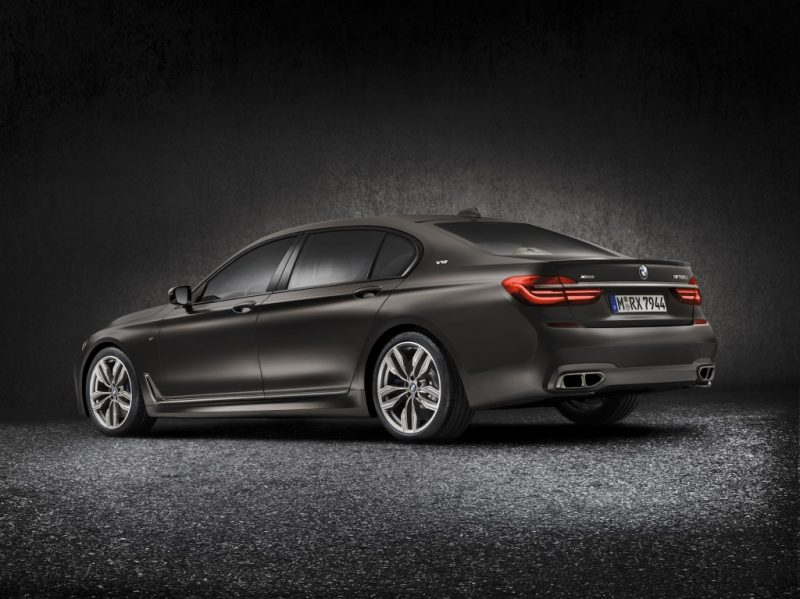
Mercedes-Maybach Vision 6 Cabriolet revealed
August 22, 2017
The Chevy Corvette ZR1 Spotted with Less Camo; Proves Porsche and Ferrari Should Worry
September 4, 2017Although the all-new BMW M5 has just officially broken cover, the model isn’t one new to the limelight, the Bavarian super sedan able to trace its history all the way back to 1984.
So, with the latest – and some might say greatest – version due to launch globally in early 2018, we thought it a perfect time to look back and see just how one of the world’s favourite executive muscle cars has evolved over the last 33 years.
First-generation E28 BMW M5
Taking the sports sedan concept to new heights, the original E28 BMW M5 took the world by storm in 1984, becoming the world’s fastest production sedan of the time.
Powered by a modified version of the naturally-aspirated 3.5-litre (3453cc) straight-six engine used in the iconic mid-engined BMW M1, the first-generation E28 M5’s powerplant featured individual throttle butterflies and produced 210kW of power and 340Nm of torque.
Equipped with a five-speed manual transmission and 16-inch wheels, the hand-built E28 M5 weighed 1498kg, measured 4620mm long, and claimed 0-100km/h in 6.5 seconds and a top speed of 245km/h.

Second-generation E34 BMW M5
Succeeding the E28 from late 1988/early 1989, the E34 BMW M5 was the first M5 to be officially sold through BMW Australia.
Still being hand-built in Germany, the second-generation M5’s outputs increased from its predecessor, with its now 3535cc straight-six engine developing 235kW and 360Nm.
Bolted up to a five-speed manual transmission, the fractionally larger-capacity in-line six-cylinder propelled the fast four-door sedan to 250km/h for the very first time.

Despite increases in both size and weight over the E28 – the E34 measuring 4720mm long and tipping the scales at 1750kg – the 3.6-litre M5 also claimed a slightly faster 0-100km/h time than the smaller, lighter E28.
An update in 1992 saw displacement of the M5’s six-cylinder grow once more, out to 3.8 litres or 3795cc, resulting in power and torque climbing to 250kW and 400Nm, respectively. The increase in outputs also helped the M5 drop below the six-second 0-100km/h mark for the first time, and was later followed by the addition of a sixth gear to the transmission.
Sadly for us Aussies, although a five-speed 3.8-litre E34 M5 was imported into Australia as an evaluation vehicle, the decision was made not to proceed with adding it to the local line-up. The car did, however, lead BMW Australia to offer local BMW enthusiasts a six-speed manual 540i with M5 chassis settings.
Even cooler, from 1992, BMW’s M Division started producing its first wagon: the E34 M5 Touring.
Limited to 891 units worldwide, the extremely rare and highly sought-after estates also represented the last hand-built M cars. Special.

Third-generation E39 BMW M5
Marking a changing of the guard in the M5’s history, in 1998, the E39 M5 became the first M5 to be built on the same assembly line as its ‘regular’ non-M 5 Series kin.
This wasn’t the only noteworthy change, with the E34’s classic straight-six superseded by a 4.9-litre V8 with four valves per cylinder.
The company’s first-ever V8 to feature variable valve timing on both the intake and exhaust camshafts, the naturally-aspirated powerplant armed the E39 M5 with 294kW and 500Nm.

Able to rev to an impressive 7000rpm, the V8 partnered with a six-speed manual transmission to reduce the M5’s 0-100km/h sprint time down to 5.3 seconds, while allowing the 4783mm-long, 1826kg four-door to crack 300km/h – with its standard 250km/h electronic limiter circumvented, anyway.
The first M5 to feature four exhaust pipes out the back, the third-generation E39 was also the first to debut a recirculating ball steering system, speed-sensitive ‘Servotronic’ power assistance, and a ‘Sport’ button that adjusted the car’s fly-by-wire throttle and electronic throttle butterflies.
Dynamic stability control (DSC) and ABS anti-lock brakes were also standard equipment.

Fourth-generation E60 BMW M5
Out with the old and in with the new. 2005 saw BMW change tack again with the M5, this time ditching the 4.9-litre V8 from the E39 and switching to a high-revving V10 – an engine that would forever mark a particular high note in the car’s history.
A 5.0-litre V10 with four-valves per cylinder, the engine was specifically designed for use in the fourth-generation E60 M5, and developed 373kW (507hp) of power at a near-ear-melting 7750rpm and 520Nm of torque at 6100rpm.
Although a six-speed manual transmission was still available for M5 die-hards in the US, for those in other markets, the E60’s introduction meant the new addition of a seven-speed single-clutch sequential automated-manual M gearbox – dubbed ‘SMG’.

Offering a launch control system intended to ensure maximum off-the-line acceleration, for purists, arguably, the transmission signalled the beginning of the end for manual M5s.
With SMG on board, however, the 4855mm-long, 1855kg E60 M5 now claimed 0-100km/h in 4.7 seconds, with BMW offering its speed-limiter-raising M Driver’s Package – taking top speed from 250km/h to 305km/h – for the first time.
Coming standard with 19-inch alloy wheels, the E60 was also the first M5 to feature a colour heads-up display.

Already a hit with fans the world over, in 2009 – before production of the V10-powered E60 ended a year later – BMW’s M Division built a one-off special, referred to internally as “the M5 CSL we never built”.
A lighter and more powerful version of the soon-to-be-replaced E60, the so-called M5 ‘CSL’ was built to help the German carmaker celebrate the 25th anniversary of the M5, but was also an unofficial final send-off for the seminal 10-cylinder S85 engine.
Claimed to be 50kg lighter than the standard E60, the M5 ‘CSL’ scored a heavily modified version of the 5.0-litre engine, with its stroke enlarged to boost capacity up to 5.5-litres. A carbon-fibre manifold was also thrown into the mix, as was a carbon-fibre roof.

Unofficially said to have churned out around 427kW and close to 542Nm, the ‘CSL’ also employed a different gearbox to the standard car.
Helping the M5 reduce its 0-100km/h time even further – down to nearer 4.0 seconds – M Division swapped out the regular car’s SMG, and instead used a unit based on the Getrag-engineered seven-speed dual-clutch transmission (DCT) fitted to the E90 M3.
Fifth-generation F10 BMW M5
Well and truly ending the M5’s short-lived V10 era, 2011 marked the arrival of an all-new fifth-generation F10 M5 – the first to employ turbocharger technology.
In what would signify yet another step-change for the super sedan, the much-loved and respected V10 was out, and a new twin-turbocharged 4.4-litre V8 was in.
Producing 412kW (560hp) and 680Nm, the new twin-turbo V8 was partnered with a seven-speed M DCT and an Active M-Differential to shift the now 4910mm-long, 1945kg M5 from 0-100km/h in 4.3 seconds, and on to a top speed of 315km/h.

Again, while the rest of the world’s only option was the paddle-shifted DCT, the US continued to be the only market where enthusiasts could special-order the F10 M5 with a six-speed manual transmission. Jerks.
As impressive as the new force-fed V8 engine was, reactions to it – and to the decision to drop the V10 – were mixed.
These reactions weren’t helped by BMW attempting to match the epic sound of the previous M5’s V10 by artificially feeding a synthesised version of the engine’s note into the car’s cabin via “engine noise played through its audio system”.
Later in the F10’s lifecycle, power jumped to 423kW, before, in 2014, BMW revealed the ‘30 Jahre M5’.
Celebrating 30 years of the M5, the 30 Jahre special edition saw outputs rise to 441kW (600hp) and 700Nm – outputs subsequently mirrored by the 2016 BMW M5 Competition Edition. Both cars were limited in number, and both claimed 0-100km/h in 3.9 seconds.

Sixth-generation F90 BMW M5
And then we arrive at today…
Thirty-three years after the very first M5 came onto the scene, BMW has officially unveiled the latest iteration of its beastly executive sedan: the all-new sixth-generation F90 M5.
Not only is it the first M5 in the model’s history to employ a four-wheel-drive system, it’s also the first to be equipped with eight gears, and, somewhat heartbreakingly, the first M5 to be automatic only – that’s right, even in the US.

BMW says the new M GmbH-developed M xDrive all-wheel-drive system is “the most emotionally engaging all-wheel-drive system yet to grace the high-performance segment.”
Quite a claim, given the M5 is now on an even more level playing field with the 445kW/700Nm quattro-equipped Audi RS7 performance and 450kW/850Nm Mercedes-AMG E63 S 4Matic – both of which rely on twin-turbo 4.0-litre V8s to make their mumbo.
Using a central transfer case with a multi-plate clutch, the all-paw M xDrive system variably distributes drive between the front and rear axles “as required”, while an Active M Differential – with a locking effect between 0 and 100 per cent – can further split torque between the rear wheels.
Configurable via three modes – ‘4WD’, ‘4WD Sport’, and a pure rear-wheel drive ‘2WD’ mode – M xDrive is also linked to BMW’s existing options of having Dynamic Stability Control (DSC) on, having it off altogether, or putting your faith in the slightly less overprotective M Dynamic Mode (MDM).

According to BMW, 4WD mode “permits slight slip through the rear wheels when accelerating out of corners”, 4WD Sport mode (with MDM activated) allows “easily controlled drifts” to be achieved, and 2WD mode lets drivers “pick their own drift angle, and treats connoisseurs to driving dynamics in their purest form”.
Anyway, enough marketing speak.
The new F90 M5’s 4.4-litre V8 is a revised version of that used in the F10 M5, however, it features a pair of newly-developed turbochargers.

Matching the F10 30 Jahre special and Competition edition M5s, power is again rated at 441kW (600hp), but torque out of the new F90 M5 is up 50Nm, from 700Nm to 750Nm.
Peak power is delivered between 5600–6700rpm and peak torque is on tap from 1800rpm to 5600rpm.
As you’d expect going from rear- to four-wheel-drive, acceleration times of the M5 have fallen, with the new sixth-generation car claiming 0-100km/h in 3.4 seconds and 0-200km/h in 11.1 seconds.
Top speed continues to be electronically limited to 250km/h, but again, buyers do have the option of BMW’s M Driver’s Package, allowing the car to stretch its legs to 305km/h.

Equipped as standard with M-tuned variable dampers – tied to ‘Comfort’, ‘Sport’, and ‘Sport Plus’ modes – and BMW’s M Servotronic steering, the new M5 is also the first to feature an individual exhaust button to “adjust the engine sound as desired”. Neat.
A carbon-fibre roof is new for 2017 too, helping the 4965mm-long F90 tip the scales at 1855kg – 90kg less than the previous F10.
The new 2017 BMW M5 is set to launch globally in March 2018, with a local arrival due to follow shortly there after. Pricing is yet to be announced, however, BMW Australia has told CarAdvice its intention is to have the new M5 undercut its $230,615 predecessor. Stay tuned…
Source: caradvice.com.au



